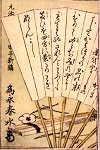| Dancing
and Diplomacy
Up until the late Meiji period, party dresses were
not a social problem for the Japanese woman. She wore her seasonal
kimono and, by tradition, rarely attended parties, certainly never
parties where foreign gentlemen and their ladies were likely to
be present. But foreign minister Inoue Kaoru attempted to change
this with a policy of entertaining foreigners in western style.
His elaborate plan called for the construction of a special building
which was Galled Rokumeikan, Inoue's idea of entertaining foreign
guests in their own fashion was not strictly for social reasons.
He, along with other Japanese ministers, believed that foreign dignitaries
and members of legations would be more likely to accept revisions
to inequitable trade agreements made by Japan when the country was
opened. These treaties, signed at a time when Japan was in no position
to bargain, were decidedly favorable to the foreign countries and
a source of continuous irritation. And so it was that a small number
of Japanese women got their first western party dresses. With the
importation of the sewing machine, the number of western dresses
available increased rapidly and a whole new dressmaking (yosai)
industry was formed. The elaborate parties had no effect upon treaty
revision. This fact, added to the expense and disregard of established
convention, brought this style of diplomacy into disrepute and ultimately
caused the resignation of foreign minister Inoue. The new foreign
minister, Okuma, believed that dancing and fancy dress balls were
the province of businessmen, not of the Japanese government.

|







